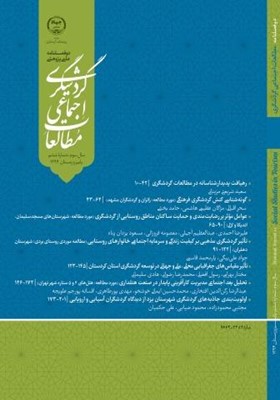گونهشناسی کنش گردشگری فرهنگی (مورد مطالعه: زائران و گردشگران مشهد )
محورهای موضوعی :
سحر اقبالی
1
,
مژگان عظیمی هاشمی
2
,
حامد بخشی
3
![]()
1 - پژوهشکده گردشگری جهاد دانشگاهی
2 - پژوهشکده گردشگری خراسان رضوی
3 - پژوهشکده گردشگری جهاد دانشگاهی مشهد
کلید واژه: کنش, گردشگری فرهنگی, سرمایههای چندگانه, رفتار گردشگر,
چکیده مقاله :
پژوهش حاضر، انواع کنش گردشگری فرهنگی و عوامل مؤثر بر آن را بین زائران و گردشگران مشهد واکاوی می کند.رویکرد نظری نگارندگان ترکیبی از نظریه های انگیزه، نگرش و سرمایه های سه گانه بوردیو است. اطلاعات مورد نیاز با استفاده از پرسشنامه با حجم نمونه 302 نفر از زائران و گردشگران مشهد در نوروز 1392 گردآوری شده است. بر اساس یافته های تحقیق، گردشگران فرهنگی به سه دسته تقسیم شدند: «گردشگران فرهنگی خاص» شامل گردشگرانی که هدف سفرشان مقصد فرهنگی است، «گردشگران فرهنگی عام» شامل گردشگرانی است که در سفرهای خود از مقصدهای فرهنگی هم بازدید می کنند و «گردشگران فرهنگی تصادفی» که برحسب اتفاق و بدون شناخت از مقصدهای فرهنگی بازدید کردهاند. نتایج تحقیق نشان میدهد امکانات و تسهیلات، نگرش به سفر فرهنگی و انگیزه برای اقدام به سفر فرهنگی تأثیرگذار است. ضریب تعیین مدل نشان میدهد، متغیرهای واردشده 45 درصداز تغییرات متغیر وابسته (کنش فرهنگی) را تبیین می-کند و میزان تحصیلات، بیشترین تأثیر را بر متغیر کنش سفر فرهنگی دارد. با توجه به نتایج تحقیق، ظرفیتهای مناسبی برای گسترش گردشگری فرهنگی و فرصت کسب تجربه برای گردشگران در بازدید از جاذبه و شرکت در رویدادهای فرهنگی وجود دارد که مخاطبان ویژة آن، افراد تحصیلکرده خواهند بود.
This study analyzes different types of cultural tourism action and its influencing factors among the pilgrims and tourists in Mashhad. The authors’ theoretical approach is a combination of motivation, attitude and Bourdieu’s capital theory.In this research required data were collected by means of a questionnaire with the sample size of 302, pilgrims and tourists, in Mashhad during March 2013(Iranian New Year holidays). Based on the research findings, the cultural tourists are divided into three categories: “specific cultural tourists” including tourists whose traveling aim is visiting cultural destination, “general cultural tourists” including tourists that during their travels, they will visit cultural destinations as well and “incidental cultural tourists” including tourists that accidentally and unknowingly will visit cultural destinations. Also, the results indicated that facilities will affect both attitudes and motivations toward cultural travel. Coefficient of determination model showed that the entered variables explain 45 % of the dependent variable variations (cultural travel action) and education level have the greatest effect on the variable of cultural travel action. Regarding the results, there are appropriate potential in order to promote cultural tourism, which will help tourists to gain more experiences while visiting cultural attractions and /or taking part in cultural events. Furthermore, it seems educated people are the main participants of this type of tourism.
